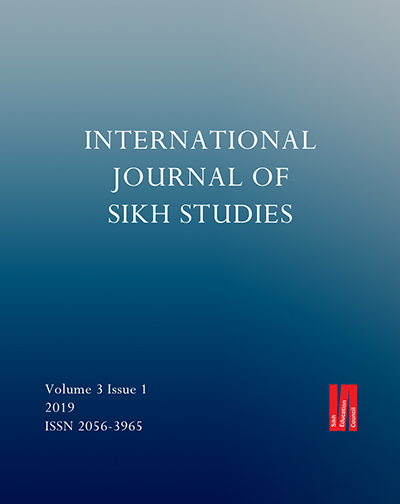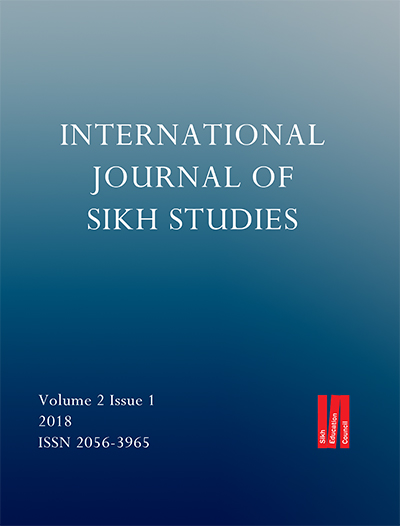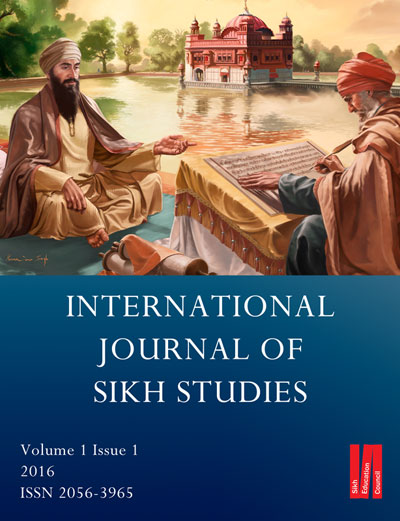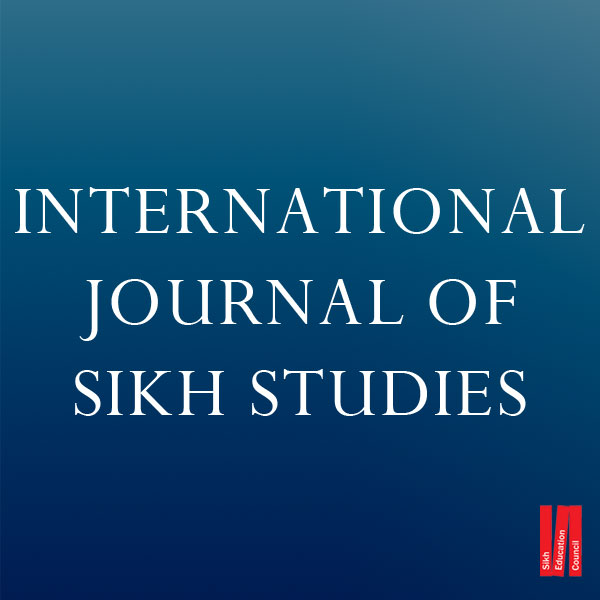Journal Issues

Volume 3 Issue 1
Copyright © 2019 Sikh Education Council.
ARTICLES
‘Status of Punjabi Language in the Pakistani Punjab’
pgs. 1-22
AKHTAR HUSSAIN SANDHU
‘Punjabi language teaching: a global perspective’
pgs. 24-40
BALDEV SINGH KANDOLA
‘Breaking Barriers: Role of Punjabipedia in Reaching out to Global Readers of Punjabi Language’
pgs. 42-64
RAJWINDER SINGH AND CHARANJIV SINGH
‘The Origin Theories of Punjabi Language: A Context of Historiography of Punjabi Language’
pgs. 66-83
SIKANDER SINGH
‘Use of the Gurmukhi Script in Writing Gurbani and Modern Panjabi: A Scientific Investigation’
pgs. 85-97
MANGAT RAI BHARDWAJ
‘Status of Punjabi Language in the Pakistani Punjab‘
Punjabi has become a popular language spoken in many parts of Pakistan because in a sizeable portion of vocabulary it offers similarity to Urdu language but yet to seek its official place in the power corridors. The capacity in the technical terminology remained a major barrier in the way of its recognition as the language of capital and business. Urdu and English being the languages of capital occupy a dominant position in the Pakistani Punjab. Maharaja Ranjit Singh could assert his position in this regard and implement Punjabi as the official language but it could not be possible because he lacked human resource which could maintain record in the Punjabi scripts. The law and order situation in different parts of the Punjab did not let Ranjit Singh to focus on the language issue. Pakistan emerged in August 1947 but Urdu having tremendous number of the people in all federating units who could understand and interact in Urdu secured its assertive position. Punjabis themselves adopted apathetic attitude towards their mother-tongue and preferred Urdu and English. For the reasons, no rule or government ascended favourable for the Punjabi language. Consequently, the Punjabi language retains its popularity among the masses yet it could not impress upon the government circles dominated by the Punjabi people to elevate it to the status of the medium of instruction or official language of the Punjab.
‘Punjabi language teaching: a global perspective‘
This paper is an effort to review the current status of the Punjabi language as taught and used internationally. For historical and socio-religious reasons the study mainly focuses on the valuable contribution made by the Sikh community and Sikh organisations in the preservation and development of the Punjabi language in India and worldwide. In this respect the post-independence achievements of the Punjabi language and the spread of Punjabi diaspora mainly in the developed countries have been reviewed as to how Punjabi has achieved the international dimension. Having achieved this status and importance it is important for the international Sikh community that these efforts should continue, and that Punjabi should become the de facto link and working language of the Gurdwaras. It is suggested that there is a need for the Gurdwaras to be linked via a common digital network. Together with this it is also important that the Punjabi teaching schools should adopt the modern teaching methods.
‘Breaking Barriers: Role of Punjabipedia in Reaching out to Global Readers of Punjabi Language‘
Regional languages contain lots of sources of understanding, community and culture. But in today world peoples are living away from their native place and so giving up their own language. According to various researches it is clear that the primary education of the child should be in the mother tongue of the child. According UNESCO reports “About half of the 6,000 or so languages spoken in the world are under threat.” So everyone have to take responsibility to save their mother tongue. Study material should be available in regional language. It may be not possible to provide in each language so providing it online is the effective way. Online encyclopaedia is the first step in it. In this paper we explain the need of regional language in education and explain the ideal how to create online encyclopaedia in regional language. In this paper authors used mother tongue and regional language as equivalent terms.
‘The Origin Theories of Punjabi Language: A Context of Historiography of Punjabi Language‘
New generations of East and West Punjab, are educated in either Indian or Pakistani education system, becoming less capable to understand vernaculars of each other. That is a result of lacking a fair language policy regarding the new creation or borrowings of required terminology. This lacking is caused to the necessity of uncontroversial and widely accepted theory regarding the origin of Punjabi language. There are some contrary, dissented and contentious origin theories available in the context which this paper examines. It critiques contradiction between Aryan and pre-Aryan origin theories of Punjabi led by non-linguistic factors i.e. political or communal ideologies. How nativeness of Punjabi was excluded from the origin context of Punjabi language and how Sanskrit and other languages were established as source of Punjabi is explored in the paper. It is analyzed that some works on history of Punjabi misdirected the future scenario which some times lead language controversies in Punjab/ India. This paper concludes to recognize a fair theory regarding the origin of Punjabi language.
‘Use of the Gurmukhi Script in Writing Gurbani and Modern Panjabi: A Scientific Investigation‘
The phonological structure of modern Eastern Panjabi and Gurbani (meant to be sung) is such that the Gurmukhi script is the best script for writing and analysing it. A few changes that have taken place in the phonological structure of Panjabi over the past four or five centuries can account for the discrepancies that have developed between the Gurmukhi spellings used in Gurbani and Modern Eastern Panjabi and modern pronunciation can be easily accounted for. The writing conventions used in Gurbani and discontinued in Modern Gurmukhi can be best studied in the light of the phonological analysis of Modern Eastern Panjabi and the language of Gurbani.

Volume 2 Issue 1
Copyright © 2018 Sikh Education Council.
ARTICLES
‘Ambedkar and Sikhism: a missed epoch’
pgs. 1-22
SRIKANTH BHORKAR
‘The use of metaphors in Indo-Sikh conflict’
pgs. 24-40
JASVIR SINGH
‘Competing nationalisms in the contestations over Sikhs’ role in 1857′
pgs. 42-64
PRITAM SINGH
‘Sikhism and Sustainability’
pgs. 66-83
NADIA SINGH
‘Punjab Unionist Party and its cross-communal status’
pgs. 85-97
AKHTAR HUSSAIN SANDHU
‘Ambedkar and Sikhism: a missed epoch‘
This article explores Dr. B. R. Ambedkar’s views on the social, political, and historical significance of Sikhism, shedding light on the key spiritual, philosophical and organizational principles of Sikhism that attracted him. This analysis will help us understand why he initially chose Sikhism as one of his main religious resorts after he left Hinduism and rejected the products of Hindu civilization, which he dismissed as a ‘felony’. This article provides a backdrop to Ambedkar’s momentous attempts and earnest endeavours to emancipate a historically wronged people during the period 1935 to 1938. The context is the political and historical developments evolving around him that involved not only him but also the forces for status-quo and hegemony in Indian society, which cut across traditional socio-religious-political lines.
‘The use of metaphors in Indo-Sikh conflict‘
This paper is an effort to investigate a unique aspect of the Indo-Sikh conflict, namely the use of particular words by Sikh nationalist leaders as metaphors. This study mainly examines the process of conducting politics through language where Sikh nationalist leaders used various historical metaphors that reflected clear connotations and a settled meaning. With the help of these metaphors, these leaders not only shaped the interpretation of particular events of the past and the present, but also defined their collective goals. This study also identifies the careful selection of metaphors by Sikh nationalist leaders for use as tools of political persuasion in their public rhetoric by drawing parallels between contemporary phenomena and past events.
‘Competing nationalisms in the contestations over Sikhs’ role in 1857‘
The British annexation of Punjab in 1849 and the ‘Indian sepoy mutiny’/ ‘war of independence’ in 1857 are two historical events that are very close to each other in time but are imbued with vastly different meanings and degrees of significance in the imagination of Punjabi/Sikh nationalism and Indian nationalism. For Punjabi/Sikh nationalism, 1849 signifies the tragic end of 50 years of sovereign Punjabi/Sikh state, and in comparison with that, 1857 is a date of relatively minor significance. For Indian nationalism, on the contrary, 1849 is of relatively ‘minor significance’- it is one date among many that signify the consolidation of British empire in ‘India’. In comparison with that, 1857 for the Indian nationalists is a date of huge meaning and significance – the Indian nationalist historiography presents this as the first war of independence from the British imperial rule. Its significance is underlined with the rise of BJP majority government in New Delhi as
it takes the writings of M.S. Golwalker, Veer Savarkar and other right wing Hindu nationalists seriously. As has been debated by other scholars, the thrust of new Indian historiography is distinctly towards recognising non-Congress groups and movements during the colonial rule. As a self-declared Hindu nationalist Veer Savarkar, of course, is the author of first major publication on 1857. He published it after devoting considerable time on it during his youthful days at India House in London. It is noteworthy how he emphasised the role of Sikhs and generally of Punjab – which subsequent writers have taken up – that had the Sikhs sided with the mutineers, India would have gained freedom almost a century earlier.
The divergence of Punjab from the rest of Indian provinces and especially from its neighbouring eastern provinces underlies far more deeper forces not acknowledged by latter day historians swayed by Indian ideology which stretches the idea of India as a nation to ancient times. This paper sees the contestation over Sikh role in 1857 as the issue of two competing nationalisms and attempts to tie up multiple and tangled aspects of the relationship between Punjabi/Sikh nationalism and Indian nationalism with the aim of drawing up as clear a picture as possible of the Sikh role in 1857. The paper is divided into three parts: one, I will provide a brief historical overview of the rise of Sikhism and Punjabi nationalism with the aim of highlighting the significance of 1849 in Punjabi/Sikh imagination; two, I will attempt to provide some historical accounts of the Sikh role in 1857 and third, I will try to examine contesting interpretations of the Sikh role in 1857.
‘Sikhism and Sustainability‘
This paper explores the rising environmental consciousness among religious organisations in Punjab. In consonance with other major religions of the world, Sikhism, the dominant religion in Punjab, is increasingly taking a green turn. Environmental advocates are reinterpreting scriptural sources and drawing on elements of Sikh history to promote Sikhism as an inherently ecological tradition. Many Sikh temples have launched a grass roots level ‘Green Gurdwara’ movement to reduce their ecological footprint through preparation of organic food in the community kitchen, planting trees, recycling waste and participating in renewable energy projects.
This field-based research documents the role of community and religious organisations in promoting ecological consciousness in Punjabi society. These organisations are promoting green initiatives by utilising the Sikh tradition of seva or voluntary service. The findings from the research reveal that these initiatives are fulfilling the aspirations of the Punjabi community for sustainable living through
innovative approaches based on community ownership and use of local resources and technologies as well as egalitarian community practices. Faith and community-based leaders are also encouraging environmental sensitivity among people and mobilising support for ecological causes.
‘Punjab Unionist Party and its cross-communal status‘
‘Was the Punjab Unionist Party a non-communal party?’ is a question yet to be responded to. S. Qalb-i-Abid determines Unionist politics as a class politics and that its leaders were working purely to retain their concessions and social status, whilst Tanwar contends that the basis of the Unionist support was too fickle to maintain it for a long time and ‘even a far weaker tide than that was created by the demand for Pakistan could have dislodged it’. Many other historians present the Punjab Unionist Party as the secular and cross-communal party in the British Punjab, which needs to be reconsidered as all Unionist candidates were elected by their respective religious communities, and their policies testify to their communal character. This article addresses the points relating to prove the communal character of the Unionist Party.

Volume 1 Issue 1
Copyright © 2016 Sikh Education Council.
Cover Illustration: ‘Guru Arjan Dev Ji – Birth of the Adi Granth‘, Kanwar Singh.
Copyright © 2005-2016 Art of Punjab
ARTICLES
‘Group Power Contest Theory and Neo-Sanatan Strategies for Countering Sikh Nationalism’
pgs. 1-26
JASVIR SINGH and SEWAK SINGH
‘Countering Oppression through Khalsa Principles: An Analysis of the Leadership Credence of Banda Singh Bahadur’
pgs. 28-42
PARGAT SINGH and PALBINDER SINGH
‘A Study of Epistemological Warfare Initiated by Brahmanical Forces Against the Sikh Way of Life’
pgs. 44-63
JASVIR SINGH
‘Group Power Contest Theory and Neo-Sanatan Strategies for Countering Sikh Nationalism‘
The main focus of this paper concerns how Indian unitary forces are applying every dimension of their power to eliminate the continuously increasing sense of Sikh National identity. We analyse how power is a significant source of the conflict between the Sikhs and Brahmanical forces, Indian unitary state and their neo-Sanatan scholars. Through this study an attempt is made to analyse how the present conflict relates Sikh nationalism to the community’s past struggle against Brahmanism. Brahmanical forces have always used the third dimension of power for dominating Sikhs, by distortion of the meanings and interpretations of Sikh history, ethos and their episteme as fixed by Guru Nanak. The theories and concepts of power and psychological warfare are used for examining this phenomenon.
‘Countering Oppression through Khalsa Principles: An Analysis of the Leadership Credence of Banda Singh Bahadur‘
This article covers the Sikh response to Mughal oppression – submission or resistance even in a “hopeless” position. Soon after the departure of the last Sikh Guru, Gobind Singh, in 1708, a dispute arose within the Sikh community at the Gurdas Nangal siege of 1715. This dispute centred around whether to follow the socio-political doctrine of the Sikh Gurus (Nankonian philosophy) which entailed living as free men, but with the risk of impending slaughter from the Mughal enemy, or surrender to “Dhimmi” status and live subordinately as non-Muslims in an Islamic state. Guru Gobind Singh’s appointed Commander-in-Chief, Banda Singh Bahadur, tackled this dispute at the Gurdas Nangal siege when he refused to surrender or accept the Mughal offer of reconciliation. This article re-evaluates strategical decisions, from a Khalsa perspective (a fearless, God-centric challenge to tyranny), by examining the similarities between the leadership of Guru Gobind Singh at the Anandpur siege of 1705 with that of Banda Singh at the Gurdas Nangal siege. The analysis of these historical events will explore the flaws and peripheral issues of surrendering to oppression and whether there are any lessons to be learnt from Banda Singh’s leadership credence. There are clear parallels between Banda Singh’s teachings and Burke’s axiom, “All that is needed for evil to triumph is for good men to do nothing”, which remains as true today as it was in the 18th Century.
‘A Study of Epistemological Warfare Initiated by Brahmanical Forces Against the Sikh Way of Life‘
In the 1980s, a number of both Indian and foreign academics began to study the Sikh religion. Based on their published works, the motives for doing so can be seen in the positions they have taken and the insights they have made about the Sikh way of life, which we have termed ‘neo-Sanatan’. Unlike previous attempts by Brahmanical scholars engaged in promoting the Indian Unitary State, these academics are widespread, professional and have worldwide amplitude. Consequently, the Sikh community’s distinct existence is being concertedly destabilised and repeated efforts to control the distribution of knowledge within the Sikh community show no signs of being curbed. The focus of this paper is to identify and analyse how this anti-Sikh episteme is being embedded in International academic circles as a “regime of truth”.
